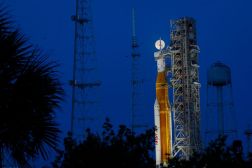Contractor issues put NASA behind schedule and over budget on robotic spacecraft, OIG finds

NASA wants to use robotic spacecraft to repair a range of in-orbit satellites. That technology, the agency believes, could help manage satellite fleets and tackle the growing challenge of space trash, which continues to crowd up low-Earth orbit.
But NASA’s initiative to build such a spacecraft, which is called On-orbit Servicing, Assembly, and Manufacturing 1 or OSAM-1, is running late and is way over budget, according to an Oct. 4 report from the agency’s Office of Inspector General.
The OIG report noted that the project is expected to exceed its more than $2 billion price tag — and run past its December 2026 expected launch date. Much of the blame for delays and cost overruns, according to the OIG, lies with Maxar Technologies, which focuses on space manufacturing. The company holds a NASA contract for a spacecraft bus and a Space Infrastructure Dexterous Robot (SPIDER).
“Although Goddard continues to struggle with development of several key components of the servicing payload, we found that project cost increases and schedule delays were primarily due to the poor performance of Maxar, OSAM-1’s prime contractor, and its inability to provide the spacecraft bus and SPIDER in accordance with contract requirements,” the report states. ”NASA and Maxar officials acknowledged that Maxar underestimated the scope and complexity of the work, lacked full understanding of NASA technical requirements, and were deficient in necessary expertise.”
The report said that Maxar is several years late on producing both the spacecraft and the robot — and also found issues with the company’s management of subcontractor personnel. The OIG also determined that, because the contracts had no incentive or award fee structure, NASA struggled to push the contractor to go above and beyond “basic contract requirements.”
Notably, NASA even provided Maxar with labor in an attempt to keep the project running on track, the report noted.
In the future, the OIG office recommended that NASA try to recoup the cost of the work it provided Maxar and integrate and update the relevant scope of work. The OIG also suggested that the space agency’s assistant administrator for procurement “issue guidance that contracting officials, as part of acquisition strategy planning, consider incorporating award or incentive fees into future fixed price development contracts.”






